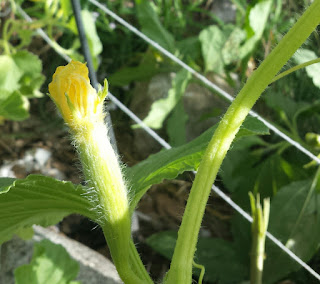Where can you use hugelkultur? Are there limitations on the kinds of places in which this method can be effective? Seems like there is only one way to find out...
On a granite outcrop near the garden, I would like to install a windbreak, privacy barrier, and shade area. This truly is hugel on the rocks. The granite bedrock is visible throughout the area, with just enough soil in between the protrusions to support some lovely native bluebunch wheatgrass, magnificent bitterroot flowers on the edges, a thick profusion of not-so-lovely invasive St. John's Wort in the center. (Above you can see beds #1 and #2 before they were covered with soil, and the rocky setting in which they are built.)
I started off by laying sheets and cardboard down over the St. John's Wort, in an effort to suppress it. Next I piled up rounds of spruce from Lee in Wauconda, short pieces about 16" high, in circles.
In the center of the top layer of rounds in bed #2, I planted lilacs that were given to me. I included lots of horse manure from my neighbor along with a little soil, compost, and hay.
Our dog, Kwilly, looks innocent enough here -- but we won't get into the number of times he tore the rounds apart to get at the compost I layered under the lilacs. Note to self: use completely composted food scraps only!
Layer one of bed #3.
Between some rounds there was a gap, so I stuffed it with punky spruce pieces. This really helps contain the horse manure for weed seed reasons, and helps keep moisture in the bed too.
I'm winging it with these circular beds made from stacked vertical pieces. They wind up being very steep sided, which makes it challenging to add the outer skin of soil.
A second layer of rounds... on bed #3
Here you can see the cardboard and cotton sheets, and my start on covering them with leaves.
I ended up fully covering the sheets with wood chips and leaves hauled from the valley, but later that winter, the deer ate most of the leaves! There is nothing easy about growing plants and managing weeds in this environment, but that makes it all the more rewarding when things do work out.
Two years later:
Orchard grass has taken over around the beds, and I still haven't managed to finish the outer skin of soil. The beds are growing fine, but more like conventional raised beds than hugelkultur rotting wood beds. If I want the wood to break down and provide the benefits of rotting wood, I need to cover the rounds with soil. It takes quite a lot of volume!
Opportunity knocks
My husband is creating a wider level area for his sawmill. In cutting into the bank, he is creating a source of native bunchgrass and beautiful soil. I won't be able to cover all of the beds, but it'll be a good start!
Loading the ATV with soil and native grass sod
Parked on a hill, letting gravity fill the wheelbarrow
Above is the progression of the bed that has the lilac, being covered with native grass sod.
And this is the bed I haven't gotten to covering with soil. It's functioning a little more like a conventional raised bed, although it does have rotting wood in its core. It now has hops growing on the outside as an experiment in lieu of a soil skin. I'm experimenting with live skins that are less labor intensive, to see how that works. In the center of this bed is Maximilian sunflower, a perennial sunflower that has been doing very well here.
A bonus:
I started out this project aiming to suppress St. John's Wort and to build a windbreak and privacy barrier. As shared in my last post, "Mycelium Magic", I got a whole lot more out of the project: here you can see morels popping up on the edges of the sheet mulch. All around the edges this spring, was the gift of morels! You may know that open, south-facing, rocky hillsides are not a place where you would usually find morels. However, the layering of manure, cardboard, leaves, and wood chips seemed to work for them. I've been inoculating other sheet mulch areas with morel spores, using newspapers upon which the mushrooms were dried. Here's hoping this is a replicable model!
Although hugel on the rocks has been a huge amount of work, it has been a lot of fun to create a new microclimate in an unlikely location. So far, I have not found a location unsuited for hugelkultur. It seems to work everywhere!
































































